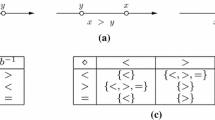Abstract
While the worst-case computational properties of Allen's calculus for qualitative temporal reasoning have been analyzed quite extensively, the determination of the empirical efficiency of algorithms for solving the consistency problem in this calculus has received only little research attention. In this paper, we will demonstrate that using the ORD-Horn class in Ladkin and Reinefeld's backtracking algorithm leads to performance improvements when deciding consistency of hard instances in Allen's calculus. For this purpose, we prove that Ladkin and Reinefeld's algorithm is complete when using the ORD-Horn class, we identify phase transition regions of the reasoning problem, and compare the improvements of ORD-Horn with other heuristic methods when applied to instances in the phase transition region. Finally, we give evidence that combining search methods orthogonally can dramatically improve the performance of the backtracking algorithm.
Similar content being viewed by others
References
Allen, J. F., & Koomen, J. A. (1983). Planning using a temporal world model. In Proceedings of the 8th International Joint Conference on Artificial Intelligence (IJCAI-83), pages 741–747.
Allen, J. F. (1983). Maintaining knowledge about temporal intervals. In Communications of the ACM 26(11):832–843.
Allen, J. F. (1991). Temporal reasoning and planning. In J. F. Allen, H. A. Kautz, R. N. Pelavin, and J. D. Tenenberg, editors, Reasoning about Plans, pages 1–67, Morgan Kaufmann.
Benzer, S. (1959). On the topology of the genetic fine structure. In Proc. Nat. Acad. Sci. USA 45:1607–1620.
Cheeseman, P., Kanefsky, B., & Taylor, W. M. (1991). Where the really hard problems are. In Proceedings of the 12th International Joint Conference on Artificial Intelligence (IJCAI-91), pages 331–337.
Feiner, S. K., Litman, D. J., McKeown, K. R., & Passonneau, R. J. (1993). Towards coordinated temporal multimedia presentation. In M. Maybury, editor, Intelligent Multi Media. AAAI Press.
Gent, I. P., & Walsh, T. (1994). The hardest random SAT problems. In B. Nebel and L. Dreschler-Fischer, editors, KI-94: Advances in Artificial Intelligence, pages 355–366, Springer-Verlag.
Gerevini, A., & Schubert, L. (1993). Efficient temporal reasoning through timegraphs. In Proceedings of the 13th International Joint Conference on Artificial Intelligence (IJCAI-93), pages 648–654.
Golumbic, M. C., & Shamir, R. (1993). Complexity and algorithms for reasoning about time: A graphtheoretic approach. In Journal of the Association for Computing Machinery 40(5):1128–1133.
Haralick, R. M., & Elliot, G. L. (1980). Increasing tree search efficiency for constraint satisfaction problems. In Artificial Intelligence 14:263–313.
Isli, A., & Bennaceur, H. (1996). Networks of qualitative interval relations: Combining circuit consistency and path consistency in the search for a solution. In Proceedings of Third International Workshop on Temporal Representation and Reasoning.
Ladkin, P. B., & Maddux, R. (1994). On binary constraint problems. In Journal of the Association for Computing Machinery 41(3):435–469.
Ladkin, P. B., & Reinefeld, A. (1992). Effective solution of qualitative interval constraint problems. In Artificial Intelligence 57(1):105–124.
Ladkin, P. B., & Reinefeld, A. (1993). A symbolic approach to interval constraint problems. In J. Calmet and J. A. Campbell, editors, Artificial Intelligence and Symbolic Mathematical Computing, volume 737 of Lecture Notes in Computer Science, pages 65–84, Springer-Verlag.
Montanari, U. (1974). Networks of constraints: Fundamental properties and applications to picture processing. In Information Science 7:95–132.
Nebel, B., & Bürckert, H-J. (1995). Reasoning about temporal relations: A maximal tractable subclass of Allen's interval algebra. In Journal of the Association for Computing Machinery 42(1):43–66.
Nökel, K. (1991). Temporally Distributed Symptoms in Technical Diagnosis, Volume 517 of Lecture Notes in Artificial Intelligence. Springer-Verlag.
Selman, B., Levesque, H. J., & Mitchell, D. (1992). A new method for solving hard satisfiability problems. In Proceedings of the 10th National Conference of the American Association for Artificial Intelligence (AAAI-92), pages 440–446.
Song, F., & Cohen, R. (1988). The interpretation of temporal relations in narrative. In Proceedings of the 7th National Conference of the American Association for Artificial Intelligence (AAAI-88), pages 745–750.
van Beek, P., & Cohen, R. (1990). Exact and approximate reasoning about temporal relations. In Computational Intelligence 6:132–144.
van Beek, P., & Manchak, D. W. (1996). The design and experimental analysis of algorithms for temporal reasoning. In Journal of Artificial Intelligence Research 4:1–18.
Vilain, M. B., & Kautz, H. A. (1986). Constraint propagation algorithms for temporal reasoning. In Proceedings of the 5th National Conference of the American Association for Artificial Intelligence (AAAI-86), pages 377–382.
Author information
Authors and Affiliations
Rights and permissions
About this article
Cite this article
Nebel, B. Solving hard qualitative temporal reasoning problems: Evaluating the efficiency of using the ORD-Horn class. Constraints 1, 175–190 (1997). https://doi.org/10.1007/BF00137869
Issue Date:
DOI: https://doi.org/10.1007/BF00137869




